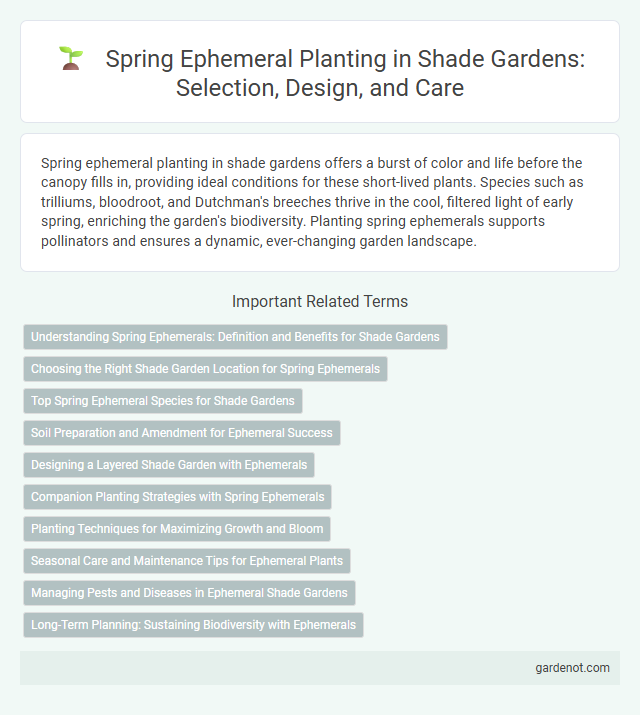Spring ephemeral planting in shade gardens offers a burst of color and life before the canopy fills in, providing ideal conditions for these short-lived plants. Species such as trilliums, bloodroot, and Dutchman's breeches thrive in the cool, filtered light of early spring, enriching the garden's biodiversity. Planting spring ephemerals supports pollinators and ensures a dynamic, ever-changing garden landscape.
Understanding Spring Ephemerals: Definition and Benefits for Shade Gardens
Spring ephemerals are perennial plants that complete their life cycle rapidly during early spring before tree canopies fully develop in shade gardens. These plants maximize light availability by emerging early, thriving in the cooler temperatures, and then going dormant as the shade intensifies. Incorporating spring ephemerals enhances biodiversity, supports pollinators, and adds seasonal interest to shade garden ecosystems.
Choosing the Right Shade Garden Location for Spring Ephemerals
Selecting the ideal shade garden location for spring ephemerals involves identifying areas with dappled sunlight and rich, well-draining soil to mimic their native woodland habitats. These plants thrive under deciduous trees where early spring sun reaches them before the canopy fully develops. Proper site selection ensures optimal growth, vibrant blooms, and healthy foliage throughout the brief spring season.
Top Spring Ephemeral Species for Shade Gardens
Spring ephemeral species like Trillium, Bloodroot (Sanguinaria canadensis), and Dutchman's Breeches (Dicentra cucullaria) thrive in shade gardens, emerging early to capitalize on sunlight before tree canopies fully develop. These plants offer vibrant foliage and delicate blooms that support early-season pollinators, while requiring minimal maintenance due to their short growing period. Incorporating species such as Virginia Bluebells (Mertensia virginica) enhances biodiversity and provides seasonal interest in shaded garden areas.
Soil Preparation and Amendment for Ephemeral Success
Spring ephemeral planting thrives in well-drained, nutrient-rich soil with a slightly acidic to neutral pH range of 6.0 to 7.0. Incorporate organic matter such as compost, leaf mold, or aged manure to enhance soil structure, moisture retention, and microbial activity critical for early growth. Amending soil with balanced slow-release fertilizers provides essential nutrients, supporting vigorous root development and prolonged blooming of ephemeral plants in shade gardens.
Designing a Layered Shade Garden with Ephemerals
Spring ephemeral planting in a layered shade garden maximizes early-season blooms while providing dynamic visual interest beneath deciduous trees. Incorporating species such as Trilliums, Bloodroot, and Dutchman's Breeches ensures a succession of color and texture, with ground covers like Violets and Foamflower adding depth. Careful spacing and soil preparation promote healthy growth, creating a sustainable understory that thrives in filtered light conditions.
Companion Planting Strategies with Spring Ephemerals
Choosing shade-tolerant spring ephemerals like Trillium, Bloodroot, and Dutchman's Breeches enhances early-season color and biodiversity in shade gardens. Companion planting with ferns and hostas helps maintain soil moisture and provides contrasting textures that support the growth of spring ephemerals. Integrating native wildflowers such as Virginia Bluebells improves pollinator attraction and creates a balanced, resilient ecosystem in shaded woodland areas.
Planting Techniques for Maximizing Growth and Bloom
Spring ephemeral planting in shade gardens thrives when bulbs and rhizomes are planted shallowly in well-drained, humus-rich soil that mimics their natural woodland environment. Ensuring consistent moisture without waterlogging encourages vigorous root development and vibrant blooms during their brief growth period. Applying a layer of organic mulch helps regulate soil temperature and retain moisture, supporting robust plant health and maximizing floral display.
Seasonal Care and Maintenance Tips for Ephemeral Plants
Spring ephemeral plants require well-drained, humus-rich soil and consistent moisture during their active growing period in early spring. After blooming, allow the foliage to die back naturally to replenish the bulbs or rhizomes for next season's growth. Avoid disturbing the root zone and minimize foot traffic to ensure healthy regeneration and longevity of these delicate shade garden natives.
Managing Pests and Diseases in Ephemeral Shade Gardens
Spring ephemeral plants in shade gardens require careful monitoring to prevent common pests like slugs, aphids, and fungal pathogens such as powdery mildew and leaf spot. Employing organic controls such as neem oil, introducing beneficial insects like ladybugs, and maintaining proper soil moisture and air circulation can significantly reduce infestations and disease outbreaks. Timely removal of infected foliage and regular garden sanitation further enhance plant health and support a thriving ephemeral garden ecosystem.
Long-Term Planning: Sustaining Biodiversity with Ephemerals
Spring ephemeral planting in shade gardens supports long-term biodiversity by providing critical early-season resources for pollinators and forest wildlife. Selecting a diverse mix of native ephemerals such as Trillium, Bloodroot, and Virginia Bluebells ensures ecosystem resilience and soil health over time. Incorporating strategic placement and succession planning helps maintain habitat complexity and promotes sustainable growth cycles year after year.
Spring ephemeral planting Infographic

 gardenot.com
gardenot.com